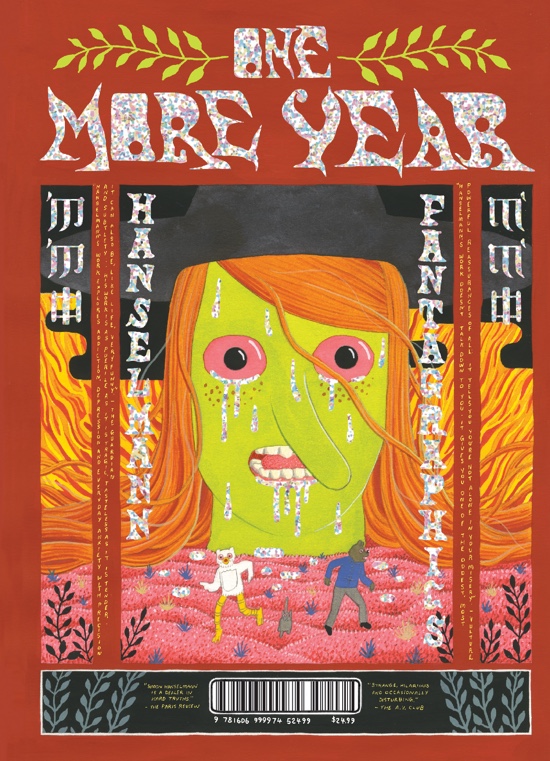The summer comics season is well underway. Back in June, ELCAF was excellent, with a great mix of tables and events. Now it’s time for Breakdown Press’ Safari Festival, taking place at Protein in London on August 12. It’s free in, and with a particularly fine lineup which in addition to the usual UK people includes Uncivilized, 2dcloud and Charles Forsman. Last year tQ favourite Alexander Tucker DJd, a fine set peppered with Grumbling Fur tracks from Furfour and the after party featured a performance by Simon Hanselmann. Don’t miss this.
Also looming fast are the Lakes International Comic Arts Festival from October 13 – 15, in partnership with Lancaster University, who are perhaps doing more to treat comics as a serious academic discipline than anyone else in the UK, and the big one, Thought Bubble in Leeds, a little earlier than usual this year, running from September 18 – 24.
Simon Hanselmann – One More Year
(Fantagraphics)
Megg, Mogg, Owl and Werewolf Jones are back, except they never really went away – the events in One More Year run parallel to those of Simon Hanselmann’s earlier Megahex. If you liked that – and I very much did – then you will like this. It’s a hard book to put down, yet one I felt the need to ration out, as I find there is always a moment of sadness when I finish one of his books, brought on by the knowledge that I won’t be getting my hands on this much Megg and Mogg for a while. There are few cartoonists that provoke this response in me, the tension between the desire to ration out the pages and the fact that it is so hard to stop reading.
Once again, I’ve had to hide this from my children as I don’t want them mistaking it for Meg & Mog. There are conversations I am not yet ready to have, and almost all of them could be triggered by this book.
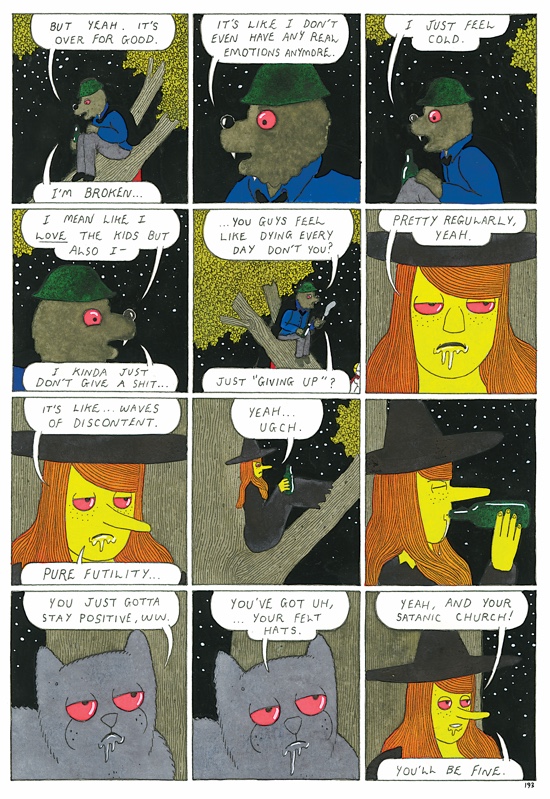
It is a particularly beautiful object, with a striking design that makes good use of glittery foil. I’ve read some of the stories before in the zines I bought at Safari Festival last year, but here they are in colour. Once again, there is a strong theme of depression, brilliantly handled in as realistic a way as possible when your characters are a witch, a cat, an owl and a werewolf in a world where just about everyone else is a normal human. There is a deepening existential despair evident – they stare into the void, and the void stares back at them, but they are too wasted to see. Hanselmann’s pacing is faultless; he’s truly the master of the awkward silence stretched out for panel after panel, such as when Owl asks the others who is more important to them, him or the proprietor of a pizza restaurant. One story, Boston Clanger, features the usual appalling events expertly delivered, whereby Owl’s room is festooned with shit as a result of an act of kindness to Werewolf Jones, and could easily have ended at this point. However, we then get two pages (and with Hanselmann’s panel size, that’s a lot) during which Owl calmly cleans this spattering of excrement, singing the Frasier theme tune to himself for what must be several hours, a bittersweet insight into his coping strategies.
The title is based on a flashback to high school, and it also appears in another story as they consider how much longer they can sustain their hedonistic ways. One can’t help but wonder where Hanselmann is going to take this. Read an interview with him, and it’s pretty clear he thinks this sort of lifestyle has a cost, and Werewolf Jones seems the most likely to pay it. Compare the character portraits on the spines of the preceding books; it’s going to get worse before it gets better. Actually, it’s probably just going to get worse. Essential. Pete Redrup
Connor Willumsen – Treasure Island Part 3
(Breakdown Press)
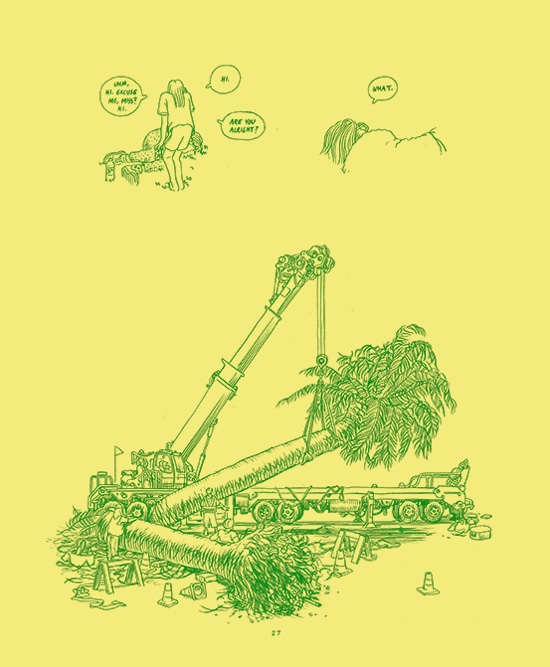
Connor Willumsen’s Treasure Island Part 3 was part of the last batch of books Breakdown Press released in 2016. If you’ve not read the first two, this is no place to start (begin here instead, as the out-of-print first part is available to read online) since Willumsen does not cater for a reader that chooses to start in the middle. Instead, he demands that you pay attention, like pretty much all of Breakdown’s output. If you’ve read but forgotten the first parts, you need to begin with those again. I recently read an article comparing his work to Jean-Luc Godard, and the same thought had occurred to me; the naturalistic dialogue convincingly establishes character without much happening, like the lengthy bedroom scene in the middle of A Bout De Souffle.
Assuming then that you have read the first two parts, we find Doug is still worried about fixing the satellite dish, and anxiously fixating on Devon, his lover in Antarctica. As Doug is in the jungle, these two couldn’t really be further apart, and we soon cut to the Antarctic research station where we find Devon is as far away emotionally as he is physically. Dr Joy’s narrative is about her ageing mother and pompous brother, which distantly unfolds in a bizarre fashion. Meanwhile, the mysterious third strand finds the duck in a tough situation, and through the phrase ‘slaughter list’ is explicitly linked to the main narrative for the first time.
I don’t know how many parts are planned, but in many ways this is still paced like a slow setup to a story that has yet to begin. There is no sense of anything getting close to a resolution; everything is just continuing to open up. In case anyone has forgotten, this book serves as an emphatic reminder that Willumsen’s an incredibly gifted artist. Careful crosshatching avoids density through empty backgrounds, providing a balanced, modern image with detail that evokes the 1970s. It’s quite possible to pay little attention to the story as such and to just revel in the awe inspiring artistic skill on display. It feels weird to call this a triumph, as it is so clearly just a section of something larger, but it is the latest part of an exceptional work unfolding, and is very special indeed. Pete Redrup
Various – Dirty Rotten Comics Issue 10
(Throwaway Press)
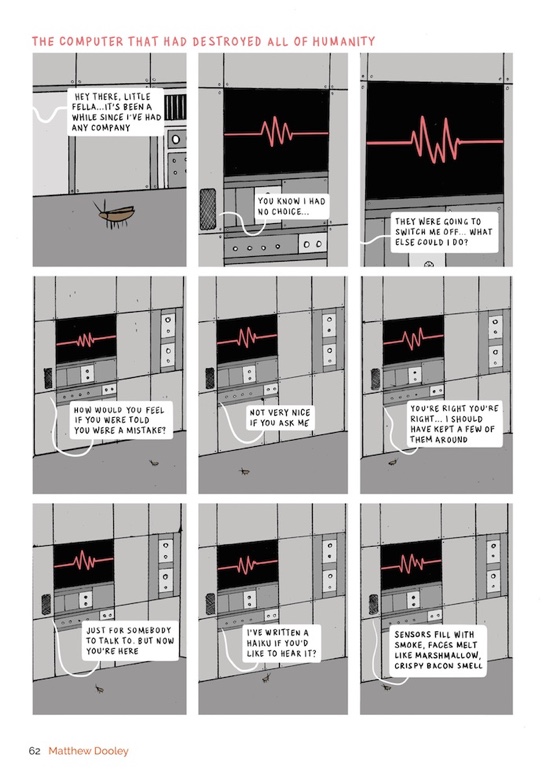
Throwaway Press’ Kirk and Gary, all round good guys of the UK small press scene, occupy a unique spot. For years they’ve been giving valuable exposure to up and coming talent with their Dirty Rotten Comics series, and this special 10th issue is in colour for the first time. It was obvious from chatting with them at ELCAF this year that their passion is undiminished, and this edition includes new work from a selection of old favourites such as Danny Noble, Rozi Hathaway and many more.
The book starts brilliantly with Alex Potts’ Out Of Hours, a satire on office life that depicts a near post-apocalyptic society living in an office building, made up of people who’ve stayed too late at work. It’s as funny as one would expect. A challenge for artists producing pieces of between one and four pages is how to deliver a full narrative. Jay Levang solves this by making great use of a killer punchline to end her two pages.
Meanwhile Tim Bird reminds us of his considerable talents; it takes real skill to wring such poetry from a visit to a motorway service station. Matthew Dooley’s darkly funny The Computer That Had Destroyed All Of Humanity raises laughs with a bleak haiku foreshadowing the end.
We also get reflections on contemporary Britain: the comic, with Fake News by Paul Shinn, and the sobering, in the form of Kathryn Briggs’ The Arrival, which eloquently and elegantly recounts the arrival of her visa, the sixth one she has had to apply for in five years. This latter piece makes excellent use of four pages to leave the reader reflecting. The colour adds to the reading pleasure throughout, but is used to best effect by the final piece, Julian Hanshaw’s Shit List #4 to humourously represent a shifting state of mind in response to location.
As expected, this is an excellent selection with an array of talent producing work making excellent use of a short format. It’s very hard to think of a single reason not to buy this. Pete Redrup
Sophie Yanow – What Is A Glacier?
(Retrofit / Big Planet)
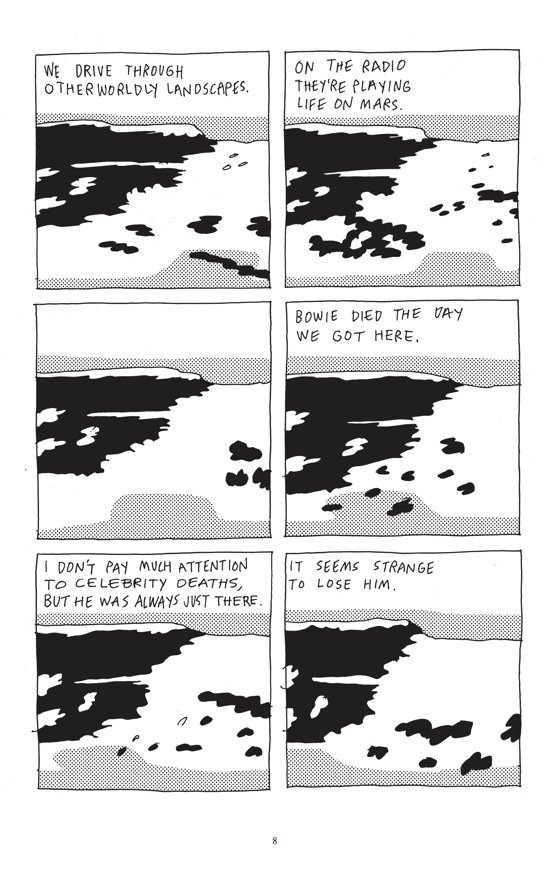
This curiously tall, beautifully printed comic from Retrofit is a fine example of Sophie Yanow’s intimate autobiographical work rather than her journalism. Ostensibly concerned with the simple question of the title, the book crams in way more than would seem possible based on the page count.
Starting with contemplation of nature on a large scale, Yanow observes “Sometimes it feels like we are trying to force revelations… Sometimes the revelations are not quite as deep as you had hoped.” Her insights into the shifting world – climate change, her own tourism accelerating this, the impact of Airbnb on local property prices for residents, mortality, immigration – are skilfully presented in a way that seems effortless and totally natural to the story. Beautifully succinct text gives us as much to savour as her images. While reflecting on a time of uncertain immigration status, she observes that “the border appeared to me in every cop – not a line, but an unfixed point that could intercept me at any moment and force me to go”.
Much of the book is about love, anxiety, mental health, grief and rituals for processing it. Her simple, loose cartooning reveals an impressive ability to communicate through body language. Yanow frequently creates a distancing effect by only drawing her glasses, not the eyes behind them. Sometimes the eyeballs appear, and a panel later, are gone again. The overall effect is charming and engrossing. In this superb comic, we find out what a glacier is, but so much more. Pete Redrup
Various – Mirror Mirror II
(2dcloud)
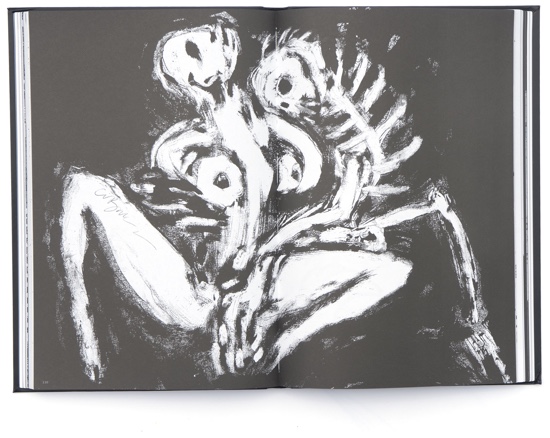
One of the fruits of 2dcloud’s last Kickstarter (they have a new one, by the way), Mirror Mirror II is a unsettling horror anthology, signaling its intention with a medieval styled Nicole Claveloux image before we’ve read a single word. The book is an eclectic mix, beautiful and unsettling, with a strong erotic element. Some pieces are purely art, others with varying degrees of narrative.
It doesn’t take long to get very disturbing – the second story, Laura Lannes’ Love, inventively combines the sexual and the horrific in a manner that would give the BBFC cause for concern were this a film. Sean Christensen’s Images Intimately is exceptional, a vignette combining sexual repression, adolescence and creative motivation quite brilliantly, reminding me a little of Eleanor Davis’ Frontier issue, BDSM, the simple black and white art and text combined with insight and subtlety. So many contributors are involved that there isn’t space to list more than a fraction, but other highlights include editor Julia Gfrӧrer’s Heroic Devices, an adaptation of a work from 1557, a series of Al Columbia strips, and a mysterious Carol Swain story.
Just before the final page (a Clive Barker sketch, since you ask) is a typically brilliant Josh Simmons piece, full of tension and self-loathing in which the protagonist’s concerns are revealed to be trivial irrelevancies in the face of horror. This serves as a particularly fine reminder of his mastery of this form. Mirror Mirror II is an immensely strong book, full of varied, challenging work that will not disappoint fans of the featured genres. If you come across a copy, I highly recommend picking it up. Pete Redrup
Comic Book Slumber Party – Deep Space Canine
(Avery Hill)
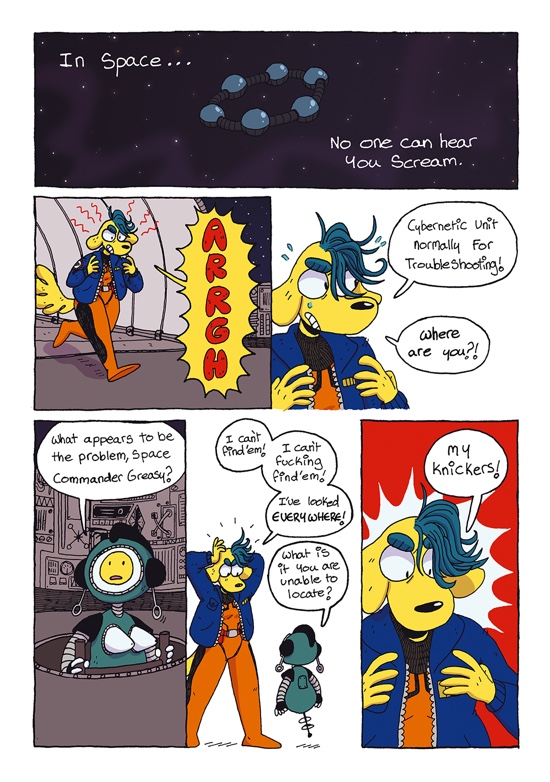
Deep Space Canine is the most recent publication from the Comic Book Slumber Party collective, published by small press stalwarts Avery Hill. The book wastes no time in establishing its sense of humour, immediately on display with a pun on ‘in space no one can hear you scream’ in the first three panels (not the only Alien reference), and in the discussion of a suitable nickname for Cybernetic Unit Normally for Troubleshooting.
The main story is drawn by Beth Wood but every few pages there’s a temporary switch to another artist. These changes are carefully executed – by timing them when Space Commander Greasy leaves her spaceship to visit a party planet, or enjoys a reflective smoke with a fellow space traveller, the stylistic shifts become a natural part of the story rather than something that jars. It’s surprisingly effective, and enjoyable to see the different representations of Greasy, from Kat Chapman’s brilliant cover to the fuzzy rendition from Honey Parast and Becca Tobin’s beautiful watercolours. In short, the art is superb. The storytelling is great fun, and it makes a refreshing change to see a sci fi comic where the only characters are female and truly badass. There are a couple of males, but they don’t merit their faces being drawn let alone being named, and don’t stick around for long. If you’re bothered by this and insist on reverse-Bechdel testing everything, the other 99.9% of literature that doesn’t do this is still available. For everybody else, this is simply a great comic that you should check out. Pete Redrup
Hannah Berry – Livestock
(Jonathan Cape)
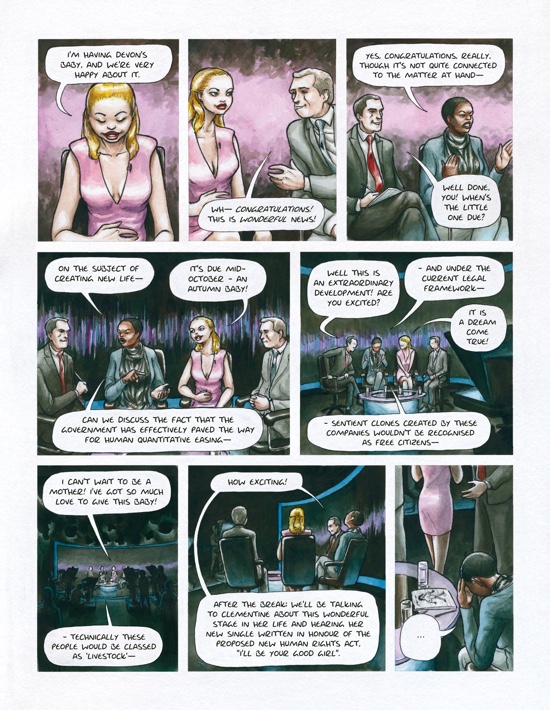
Graphic novels take a long time to write, so either Hannah Berry accurately predicted the present a few years ago, or Jonathan Cape’s PR department have managed to coordinate some truly impressive support from governments worldwide in ensuring that we move rapidly closer to dystopia just as this book is published. This sharp satire, almost a little too on the nose by the time of publication, takes a populace easily distracted by celebrity culture to its logical extreme. In Berry’s world politicians and celebrities are one, controlled behind the scenes. Is this so far from where we are now, with rentabuffoons like Boris Johnson more notable for his antics than his political work, and a celebrity in the White House more interested in Twitter spats than behaving with a dignity commensurate with his office?
Clementine Darling looks set to win Best Female Singer And Political Spokesperson at the Twammies. Her love life and celebrity spats are given plenty of press attention, leaving little airtime for concerns about government corruption and human cloning. The fast paced story contains sharp little digs at Theresa May, who was helpfully announcing plans to scrap human rights legislation as I was reading this book (although, as it turned out, it was May who had to abandon much of her plans). Amid the action are several “What’s trending” pages, where large panels recount celebrity gossip and smaller ones to the side – a sidebar of shame – contain political news showing moves towards totalitarianism as human rights laws are eroded. Wryly amusing adverts at the edge add to an atmosphere not unlike a Black Mirror episode.
With the understated, chilling final images, this book left me alternating between being entertained and disquieted. In a recent interview, Berry revealed that she is planning to make this her final graphic novel, so buy this now while it can still be described as a work of fiction. Pete Redrup
Yeon-Sik Hong – Uncomfortably Happily
(Drawn & Quarterly)
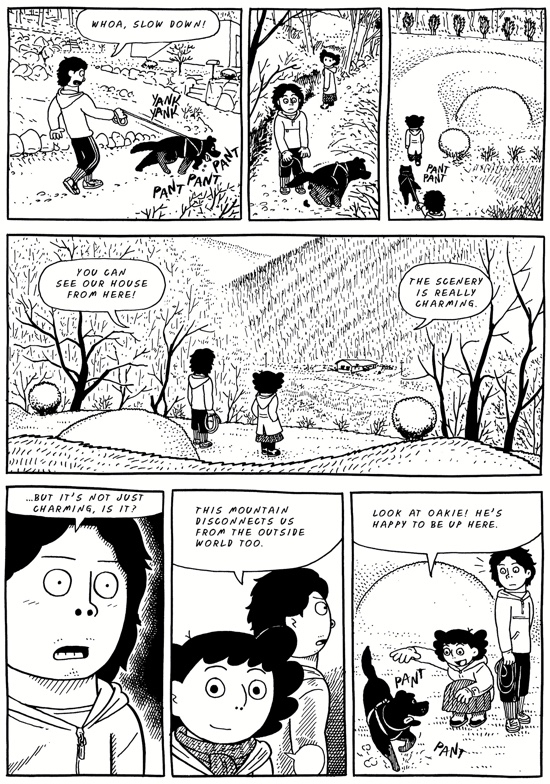
Yeon-Sik Hong’s Uncomfortably Happily is a graphic memoir covering a couple of years when he and his wife moved from Seoul to a remote house on a mountain. Working for a manga publisher, he dreams of writing his own project. He’s not the perfect employee, and his editor is not the perfect employer, resulting in numerous tense exchanges. He’s late with his pages, and she likes to call early in the morning and go through corrections on the phone, while he would prefer that she emails them to him. Meanwhile Hong’s wife is looking for a new apartment on her own as he’s too busy working to help. Seoul is portrayed as a sensory barrage of noise and smell, and so when they find a chance to move to the countryside, they do.
The years of working on comics for other people have clear rewards beyond the royalties – Hong is a highly skilled cartoonist. There are so many inventive touches, like drawing himself as a robot as he receives instruction after instruction from his editor, or representing inner monologues by drawing multiple instances of his character conversing with each other. Many pages are quite minimal, but when depicting the beautiful scenery he adds considerably more detail to great effect.
There are overlapping cycles of friction throughout the book: where to live, problems with Hong’s editor, money worries, the isolation of living on the mountain (especially during winter and when they have no transport), the desire to produce his own work rather than being a cartoonist for hire, and more. A common theme is his procrastination, exacerbated by the new home, which requires a lot of work to make it a viable place to live. He often gets stuck into projects like removing the rocks from the garden while neglecting his work, then makes himself ill trying to catch up. Meanwhile, his wife makes excellent progress on her own cartooning, as she is less of a perfectionist and more of a finisher, and pride and resentment fight for dominance of his feelings about this. Of course, there is much more depicted here than his own internal conflicts. The book provides fascinating insights into life in Korea, cycles of nature and the relationships by different people in a community, those who visit his rural idyll as tourists and those who own the land. The couple live a simple life, where eating meat is a real luxury and seemingly their only indulgence, and they are constantly juggling their finances to have enough to eat and heat. Phone and internet access, both of which are vital for his work, are cut off as bills go unpaid, and he sometimes skips class to avoid the expense of a bus fare. All of this combines to produce a book that is a pleasure to read, with the creative and striking artwork and the focus on inner and outer struggles ensuring it’s an engrossing read, and much faster than the near-600 page count would suggest. Pete Redrup
Catel Muller and José-Louis Bocquet – Josephine Baker
(SelfMadeHero)
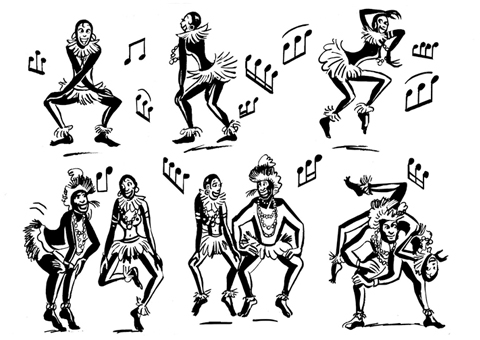
This biography from SelfMadeHero is a substantial proposition, and I must admit its sheer size put me off getting around to reading it for some while. Once I began though, the reading was very pleasant and easy going. As one of the first women of colour to achieve fame and fortune across Europe, and eventually in her homeland of America, Josephine Baker is a name everyone should know and her story is as relevant now as ever. The quote on the back of the book makes reference to the civil rights movement and much is made of the difference between the official segregation in the US and the relatively relaxed attitudes to race in Paris in the first half of the 20th century. This is clearly a selling point for the book and a central theme, although not particularly polemical. The creators play with our perceptions of truth, and Josephine seems at times to be oblivious and at others paranoid, she’s certainly not a simple heroine. Though this is pretty much a straight forward telling of Baker’s life from beginning to end, it never feels dry or slow but keeps a fresh and very readable pace. It totals at 568 pages, the final 86 being devoted to ‘supplementary material’, a fact I was not aware of because I read the book before the press release. Therefore the subject’s death was a surprise to me as I thought I had 80 odd pages to go and it packed an added emotional punch for this reason. But I don’t think many people could read this account without becoming emotionally involved and quite attached to the famous dancer. Baker’s expressive character and infectious joy made her world famous but especially she has become a symbol of Paris. This book shows that love affair between a city and a black dancer from St Louis, but also shows the twists and turns of her story in many times and places, from Mississippi to Malta, Corsica to Cuba.
Muller’s art is economical and loose, and carries the story around the world while Bocquet’s dialogue manages to pack a whole lot of exposition in without feeling unnatural. Josephine certainly had a lot of famous friends and at times the names drop so hard and fast you feel like you’re being clicked through Wikipedia at speed with no time to read below the line. At times I was reading with that lazy researcher’s friend open on my phone as I tried to keep up, something which I didn’t really need to do if I’d realised there was so much information at the back of the book. I quite wish that the editors had included references and footnotes, to let the reader know when more information was available, and which page it could be found on, although this may have interfered somewhat with the flow of the story. The tone never grovels either; stars of art, movies, music are treated in much the same tone as Baker’s family and friends from before she was famous. If you’ve ever or never wondered about the story behind the girl with the banana skirt, or the Résistance spy, or the civil rights activist then this is a must read, once you can find the time to pick up such a brick of a book. Jenny Robins
John Cei Douglas – Badger Vs. Tiger
(Self published)
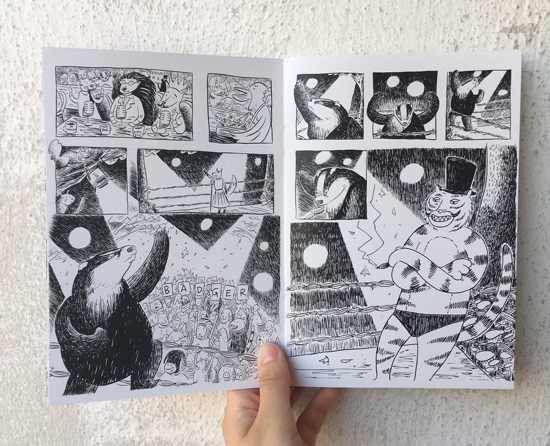
In Badger Vs. Tiger, John Cei Douglas brings us "a comic story for anyone that likes badgers, tigers, or professional wrestling (but with animals)." Everything intersects guys, you know? I know quite a few comics fans who are also wrestling fans (ok yes, they are all male). Is the crossover so simple? Biff? Pow? Thwok? etc. On both sides of the Pacific the action-packed fight scene is a staple of graphic narrative. Douglas plays with these conventions creating tension and mood, the roar of the crowd is almost audible, and the balance of contrast on the pages is dynamic and textured. But no super powers or good versus evil here, just a good old down to earth British badger, facing off against an "international" tiger. I’m not entirely sure if there’s meant to be a political metaphor there.
Badger certainly has the popular support of his fellow woodland creatures and family; his character is lovingly sketched out as the local hero with loyal friends. The illustrated heritage that is inevitably evoked by these characters is genteel, from Beatrix Potter and Winnie the Pooh to Animals Of Farthing Wood and Fantastic Mr Fox, the woodland setting and retro stylings of the characters evoke a nostalgic childhood feel. John combines these two territories (the gentle childlike animal action and the visceral and dynamic violence) elegantly and engagingly. The choice to do an almost wordless comic leaves it up to the blurb on the back to give any detailed exposition, so feel free to read that first. But words are not needed to capture the energy and emotion of what is a grudge match you don’t want to miss.
You can get hold of Badger Vs. Tiger, and John’s other excellent (usually less violent) comic works here. Jenny Robins

